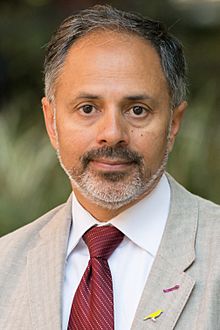Sanjiv Sam Gambhir facts for kids
Quick facts for kids
Sanjiv Sam Gambhir
|
|
|---|---|
 |
|
| Born | November 23, 1962 Ambala, Haryana, India
|
| Died | July 18, 2020 (aged 57) |
| Nationality | American |
| Alma mater | Arizona State University (B.S.), University of California, Los Angeles (M.D. & Ph.D.) |
| Known for | Molecular Imaging, Nuclear Medicine, PET-CT, and Early Cancer Detection |
| Awards | Institute of Medicine (IOM) of the US National Academies (2008) National Academy of Inventors (2015) |
| Scientific career | |
| Fields | Nuclear Medicine, Radiology, and Bioengineering |
| Institutions | Stanford University |
| Academic advisors | M.E. Phelps, S.C. Huang, and H.R. Herschman |
Sanjiv Sam Gambhir (born November 23, 1962 – died July 18, 2020) was an American doctor and scientist. He was a top professor at Stanford University School of Medicine. There, he led the Department of Radiology. He also worked in Bioengineering and Materials Science.
Dr. Gambhir directed several important centers at Stanford. These included the Molecular Imaging Program and the Canary Center for Cancer Early Detection. He was famous for his work in molecular imaging. This means he found ways to see what happens inside living bodies. He also focused on finding cancer very early. He wrote many scientific papers and held over 40 patents. His discoveries were featured on the covers of major science magazines like Nature and Science. He also helped start several biotech companies. He taught and guided over 150 students and researchers.
Contents
About Sanjiv Sam Gambhir
Sanjiv Gambhir was born in Ambala, India. In 1969, he moved to the United States with his family. He grew up in Phoenix, Arizona. He was married to Aruna Bodapati Gambhir and lived in the Bay Area. Sadly, he passed away on July 18, 2020, from cancer. His son, Milan Gambhir, was born in 1998 and died from a serious brain tumor called glioblastoma in 2015.
Education and Career Path
Dr. Gambhir was a very smart student. He graduated from Arizona State University with a degree in physics. He was part of the Phi Beta Kappa honor society. After that, he went to the University of California, Los Angeles (UCLA). There, he earned both his medical degree (M.D.) and a Ph.D. in biomathematics.
In 1994, he started teaching at UCLA as a professor. He worked in the Nuclear Medicine Department at UCLA starting in 1997. In 2003, he became a tenured professor at UCLA. This means he had a permanent teaching position. Later that year, he moved to Stanford University. At Stanford, he became a professor of radiology and led the nuclear medicine department. He also directed several research centers. In 2009, he became the Virginia and D.K. Ludwig Professor. This is a special position for cancer research. In 2011, he became the head of the radiology department.
Awards and Recognitions
Dr. Gambhir received many important awards for his work. Here are some of them:
- Taplin Award
- Holst Medal
- Academy of Molecular Imaging (AMI) Distinguished Basic Scientist of the Year Award
- Society for Molecular Imaging (SMI) Achievement Award
- Distinguished Clinical Scientist Award from the Doris Duke Charitable Foundation
- Hounsfield Medal (Imperial College London)
- Fellowship of the American Institute for Medical and Biological Engineering (AIMBE)
- Paul C. Aebersold Award
- Organizer and co-chair for the Nobel Symposium in Imaging (2008)
- Member of the American Society for Clinical Investigation (ASCI)
- Tesla Medal
- Elected to the Institute of Medicine (IOM) of the US National Academies
- Parmley Prize
- Radiological Society of North America (RSNA) Outstanding Researcher Award
- Gopal Subramanian Lifetime Achievement Award
- George Charles de Hevesy Nuclear Pioneer Award
- Aunt Minnie Award
- Distinguished Scientist Award for Distinguished Contributions to Nuclear Medicine
- Society of Asian American Scientists in Cancer Research Award
- American Association of Indian Scientists in Cancer Research Lifetime Achievement Award
- American Association for the Advancement of Science (AAAS) Fellow Award
- J. Allyn Taylor International Prize in Medicine
- National Academy of Inventors
- Basic Science Teaching Award
- Benedict Cassen Prize for Research in Molecular Imaging
- Institute of Electrical and Electronics Engineers (IEEE) Marie Sklodowska-Curie Award
What He Studied
Dr. Gambhir's research focused on creating new ways to image what happens inside living bodies. He especially wanted to find and manage cancer. A big part of his work was about finding cancer very early. This included combining methods to look inside the body (in vivo) and outside the body (in vitro) to diagnose diseases.
Key Discoveries
Dr. Gambhir made many important contributions to science. Some of his major discoveries and areas of work include:
- PET reporter gene technology: A way to use special genes to see what's happening inside cells with PET scans.
- Multimodality reporter genes: Using different imaging methods together to get a clearer picture.
- Imaging gene and cell therapies: Tracking how new treatments using genes or cells work in the body.
- Imaging the immune system: Seeing how the body's defense system responds to diseases.
- Imaging events inside cells: Looking at tiny interactions between proteins inside living cells.
- Bioluminescence resonance energy transfer (BRET): A method to see interactions deep inside living subjects using light.
- Nanoparticle-based imaging: Using tiny particles to improve imaging.
- Raman imaging and photoacoustic molecular imaging: New ways to see inside the body using light and sound, with special imaging agents.
- Decision Management Models for FDG PET in cancer: Helping doctors decide how to use a specific type of PET scan (FDG PET) for cancer.

